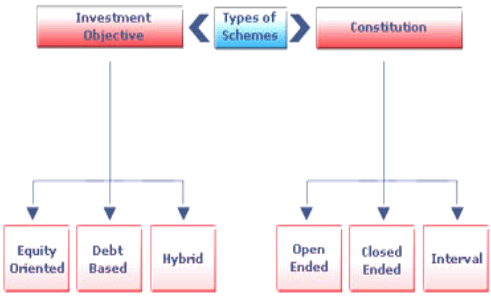| What is a Mutual Fund? |
|
A
Mutual Fund is a trust that pools together the savings of a
number of investors who share a common financial goal. The money
collected is then invested in capital market instruments such as
shares, debentures and other securities based on their
objective. The income earned through these investments and the
capital appreciation realized are shared by its unit holders in
proportion to the number of units owned by the investors.
|
|
What
are the different types of fund ?
What are open-ended funds? An open-end fund is one that is available for subscription all through the year and is not listed on the stock exchanges. The majority of mutual funds are open-end funds. Investors have the flexibility to buy or sell any part of their investment at any time at a price linked to the fund's Net Asset Value. What are close-ended funds? A closed-end fund has a fixed number of shares outstanding and operates for a fixed duration (generally ranging from 3 to 15 years). The fund would be open for subscription only during a specified period and there is an even balance of buyers and sellers, so someone would have to be selling in order for you to be able to buy it. Closed-end funds are also listed on the stock exchange so it is traded just like other stocks on an exchange or over the counter. Usually the redemption is also specified which means that they terminate on specified dates when the investors can redeem their units. What are interval funds? These schemes combine the features of open-ended and closed-ended schemes. They may be traded on the stock exchange or may be open for sale or redemption during pre-determined intervals at NAV based prices.
|
|
What are Growth / Equity Oriented SchemeWhat are Growth / Equity Oriented Scheme ? The aim of growth funds is to provide capital appreciation over the medium to long- term. Such schemes normally invest a major part of their corpus in equities. Such funds have comparatively high risks. These schemes provide different options to the investors like dividend option, capital appreciation, etc. and the investors may choose an option depending on their preferences. The investors must indicate the option in the application form. The mutual funds also allow the investors to change the options at a later date. Growth schemes are good for investors having a long-term outlook seeking appreciation over a period of time. What are Income / Debt Oriented Scheme? The aim of income funds is to provide regular and steady income to investors. Such schemes generally invest in fixed income securities such as bonds, corporate debentures, Government securities and money market instruments. Such funds are less risky compared to equity schemes. These funds are not affected because of fluctuations in equity markets. However, opportunities of capital appreciation are also limited in such funds. The NAVs of such funds are affected because of change in interest rates in the country. If the interest rates fall, NAVs of such funds are likely to increase in the short run and vice versa. However, long term investors may not bother about these fluctuations. What is Balanced Fund? The aim of balanced funds is to provide both growth and regular income as such schemes invest both in equities and fixed income securities in the proportion indicated in their offer documents. These are appropriate for investors looking for moderate growth. They generally invest 40-60% in equity and debt instruments. These funds are also affected because of fluctuations in share prices in the stock markets. However, NAVs of such funds are likely to be less volatile compared to pure equity funds. What are Money Market / Liquid Fund / income funds? These funds are also income funds and their aim is to provide easy liquidity, preservation of capital and moderate income. These schemes invest exclusively in safer short-term instruments such as treasury bills, certificates of deposit, commercial paper and inter-bank call money, government securities, etc. Returns on these schemes fluctuate much less compared to other funds. These funds are appropriate for corporate and individual investors as a means to park their surplus funds for short periods What is Equity Linked Saving Schemes (ELSS)?
Equity linked saving schemes (ELSS), these schemes are
open-ended growth schemes with a mandatory 3-year lock- in.
These schemes offer the benefit of section 80(C) of IT Act, up
to a maximum of Rs 100,000 What are Index Funds? Index Funds replicate the portfolio of a particular index such as the BSE Sensitive index, S&P NSE 50 index (Nifty), etc. These schemes invest in the securities in the same weightage comprising of an index. NAVs of such schemes would rise or fall in accordance with the rise or fall in the index. What are sectoral specific funds? These are schemes whose objective is to invest only in the equity of those companies existing in a specific sector, as laid down in the fund’s offer document. For example, an FMCG sectoral fund shall invest in companies like HLL, Cadbury’s, Nestle etc., and not in a software company like Infosys. Currently there exist approximately four broad classifications of basic sectors namely – technology, media & telecom (TMT), fast moving consumer goods (FMCG), basic industry (that invest in core industries like petrochemicals, cement, steel, etc.) and pharmaceuticals. |
|
What is a Fund of Funds (FoF) scheme? A scheme that invests primarily in other schemes of the same mutual fund or other mutual funds is known as a FoF scheme. A FoF scheme enables the investors to achieve greater diversification through one scheme. It spreads risks across a greater universe. What is an entry load? The costs of the fund management process that includes marketing and initial costs are charged when you enter the scheme. These charges are termed the entry load. It is the additional charge you pay when you join a scheme. What is an exit load? Just like entry load some funds impose a fee when you leave the scheme, i.e., redeem your units, called the exit load. |

